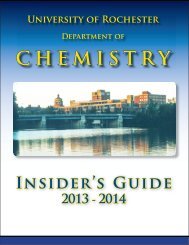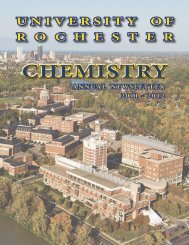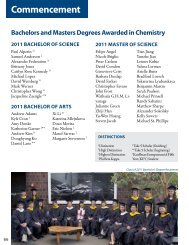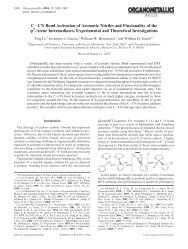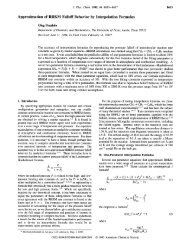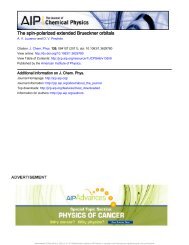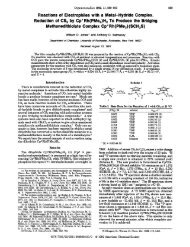Organometallics, 1999, 18, 1754-1760 - Chemistry - University of ...
Organometallics, 1999, 18, 1754-1760 - Chemistry - University of ...
Organometallics, 1999, 18, 1754-1760 - Chemistry - University of ...
Create successful ePaper yourself
Turn your PDF publications into a flip-book with our unique Google optimized e-Paper software.
C-H Activation and Ligand Exchange <strong>of</strong> CpRe(PPh 3 ) 2 H 2 <strong>Organometallics</strong>, Vol. <strong>18</strong>, No. 9, <strong>1999</strong> 1755<br />
Scheme 1.<br />
“Simple” H/D Exchange Mechanism<br />
Figure 1. UV-vis spectrum <strong>of</strong> 1 in C 6 H 6 . The absorbances<br />
<strong>of</strong> the 365 nm band-pass and 345 nm long-pass filters used<br />
are also shown.<br />
deuterium into the hydride positions <strong>of</strong> the catalyst. The<br />
studies presented in this paper shed light on the<br />
photochemistry <strong>of</strong> 1, in terms <strong>of</strong> both the phosphine<br />
substitution and the H/D exchange reaction. A new<br />
mechanism is proposed that builds upon literature<br />
precedents involving migration <strong>of</strong> the hydride ligands<br />
to the Cp ring.<br />
Results<br />
Preparation and H/D Exchange Reactivity <strong>of</strong><br />
CpReH 2 (PPh 3 ) 2 (1). The reaction <strong>of</strong> ReH 7 (PPh 3 ) 2 with<br />
excess cyclopentadiene in THF yields the η 4 -cyclopentadiene<br />
complex (η 4 -C 4 H 6 )ReH 3 (PPh 3 ) 2 , which is easily<br />
converted to 1 by the thermal loss <strong>of</strong> H 2 at 60 °C. 7<br />
Thermolysis <strong>of</strong> samples <strong>of</strong> 1 at elevated temperatures<br />
(up to 220 °C) results in no reaction (either ligand<br />
exchange with phosphine or solvent activation), as<br />
evidenced by NMR spectroscopy. 6 As mentioned above,<br />
however, photolysis <strong>of</strong> samples <strong>of</strong> 1 (λ > 345 nm) shows<br />
evidence for both ligand exchange reactions (with a<br />
variety <strong>of</strong> σ-donor ligands) and reversible C-H activation<br />
reactions (by H/D exchange with deuterated solvents).<br />
The UV-vis spectrum <strong>of</strong> 1 in C 6 H 6 shows a welldefined<br />
absorption maximum at 328 nm (ɛ ) 1413 M -1<br />
cm -1 ; Figure 1). Table 1 shows several examples <strong>of</strong> the<br />
H/D exchange reactions catalyzed by 1. Figure 2 shows<br />
how the H/D exchange is initially linear but slows with<br />
continued irradiation due to the formation <strong>of</strong> small<br />
amounts <strong>of</strong> PPh 3 that are produced by the slow photodecomposition<br />
<strong>of</strong> 1. Free PPh 3 (∼1-2%) is observed in<br />
these samples as the photolysis proceeds. The H/D<br />
exchange can be completely inhibited by the addition<br />
<strong>of</strong> free PPh 3 to the initial solution.<br />
As indicated in Table 1, the primary C-H bonds <strong>of</strong><br />
propane are much more reactive than the secondary<br />
C-H bonds, yet the secondary bonds <strong>of</strong> cyclopentane<br />
are as reactive as the primary C-H bonds <strong>of</strong> propane<br />
(7) Jones, W. D.; Maguire, J. A. <strong>Organometallics</strong> 1987, 6, 1301-<br />
1311.<br />
Table 1. Photochemical H/D Exchange Reactions<br />
Catalyzed by CpRe(PPh 3 ) 2 H 2 in C 6 D 6<br />
a<br />
alkane [alkane], M<br />
irradiation time,<br />
min no. <strong>of</strong> turnovers<br />
methane ∼0.04 <strong>18</strong>0 68<br />
ethane 2 300 33<br />
propane 2 60 51, c 2.5 d<br />
120 72, c 4.0 d<br />
<strong>18</strong>0 77, c 4.0 d<br />
cyclopropane 5 40 250<br />
70 369<br />
120 409<br />
<strong>18</strong>0 423<br />
cyclopentane 1.2 30 42<br />
70 74<br />
120 87<br />
300 90<br />
THF b 6.2 60 488, e 840 f<br />
100 520, e 895 f<br />
a [CpRe(PPh 3) 2H 2] ) 1.2 mM. b [CpRe(PPh 3) 2H 2] ) 0.6 mM.<br />
c Primary exchange. d Secondary exchange. e β exchange. f R exchange.<br />
Figure 2. Photocatalyzed H/D exchange between n-<br />
pentane and C 6 D 6 by 1.<br />
in independent experiments. Figure 3 shows a plot <strong>of</strong><br />
the H/D exchange between propane and C 6 D 6 solvent<br />
as a function <strong>of</strong> alkane concentration. From the initial<br />
rates <strong>of</strong> exchange, the reaction appears to be first order<br />
in propane concentration.<br />
In addition, competition studies were performed using<br />
a mixture <strong>of</strong> alkanes in C 6 D 6 . Irradiation <strong>of</strong> 1 in the<br />
presence <strong>of</strong> a CH 4 /C 2 H 6 mixture (100 equiv each)<br />
revealed a 2:1 kinetic selectivity for H/D exchange into<br />
methane vs ethane on a per-molecule basis. Similarly,




